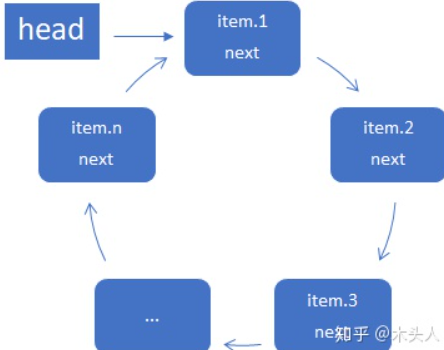链表
链表是一种在存储单元上非连续、非顺序的存储结构。数据元素的逻辑顺序是通过链表中的指针链接次序实现。链表是由一系列的结点组成,结点可以在运行时动态生成。每个结点包含两部分:数据域与指针域。数据域存储数据元素,指针域存储下一结点的指针。
资料来源:https://zhuanlan.zhihu.com/p/60057180
单向链表
它的每个节点包含两个域,一个信息域(元素域)和一个链接域。这个链接指向链表中的下一个节点,而最后一个节点的链接域则指向一个空值。
由图可知:
head保存首地址,item存储数据,next指向下一结点地址。
链表的优缺点:
- 链表失去了序列的随机读取优点,同时链表增加了指针域,空间开销也较大。
- 但它对存储空间的使用要相对灵活。
- 优势示例:
- 列如:有一堆数据[1,2,3,5,6,7],要在3和5之间插入4, 如果用数组,需要将5之后的数据都往后退一位,然后再插入4,这样非常麻烦,但是如果用链表,我就直接在3和5之间插入4就行。
定义节点
结点的数据结构为数据元素(item)与 指针(next)
class Node(object):"""单链表的结点"""def __init__(self, item):# item存放数据元素self.item = item# next是下一个节点的标识self.next = None
定义链表
链表需要具有首地址指针head。
class SingleLinkList(object):"""单链表"""def __init__(self):self._head = None
示例:创建链表
class Node(object):"""单链表的结点"""def __init__(self, item):# item存放数据元素self.item = item# next是下一个节点的标识self.next = Noneclass SingleLinkList(object):"""单链表"""def __init__(self):self._head = Noneif __name__ == '__main__':# 创建链表link_list = SingleLinkList()# 创建结点node1 = Node(1)node2 = Node(2)# 将结点添加到链表link_list._head = node1# 将第一个结点的next指针指向下一结点node1.next = node2# 访问链表print(link_list._head.item) # 访问第一个结点数据 输出:1print(link_list._head.next.item) # 访问第二个结点数据 输出:2
在链表中添加操作方法(增删改查)
主要实现功能如下:
is_empty()链表是否为空length()链表长度items()获取链表数据迭代器add(item)链表头部添加元素addend(item)链表尾部添加元素insert(pos,item)指定位置添加元素remove(item)删除节点find(item)查找节点是否存在
代码如下:
class Node(object):"""单链表的结点"""def __init__(self, item):# item存放数据元素self.item = item# next是下一个节点的标识self.next = Noneclass SingleLinkList(object):"""单链表"""def __init__(self):self.head = Nonedef is_empty(self):"""判断链表是否为空"""return self.head is Nonedef length(self):"""链表长度"""# 初始指针指向headcur = self.headcount = 0# 指针指向None 表示到达尾部while cur is not None:count += 1# 指针下移cur = cur.nextreturn countdef items(self):"""遍历链表"""# 获取head指针cur = self.head# 循环遍历while cur is not None:# 返回生成器yield cur.item# 指针下移cur = cur.nextdef add(self, item):"""向链表头部添加元素"""node = Node(item)# 新结点指针指向原头部结点node.next = self.head# 头部结点指针修改为新结点self.head = nodedef append(self, item):"""尾部添加元素"""node = Node(item)# 先判断是否为空链表if self.is_empty():# 空链表,head 指向新结点self.head = nodeelse:# 不是空链表,则找到尾部,将尾部next结点指向新结点cur = self.headwhile cur.next is not None:cur = cur.nextcur.next = nodedef insert(self, index, item):"""指定位置插入元素"""# 指定位置在第一个元素之前,在头部插入if index <= 0:self.add(item)# 指定位置超过尾部,在尾部插入elif index > (self.length() - 1):self.append(item)else:# 创建元素结点node = Node(item)cur = self.head# 循环到需要插入的位置for i in range(index - 1):cur = cur.nextnode.next = cur.nextcur.next = nodedef remove(self, item):"""删除节点"""cur = self.headpre = Nonewhile cur is not None:# 找到指定元素if cur.item == item:# 如果第一个就是删除的节点if not pre:# 将头指针指向头节点的后一个节点self.head = cur.nextelse:# 将删除位置前一个节点的next指向删除位置的后一个节点pre.next = cur.nextreturn Trueelse:# 继续按链表后移节点pre = curcur = cur.nextdef find(self, item):"""查找元素是否存在"""return item in self.items()if __name__ == '__main__':link_list = SingleLinkList()# 向链表尾部添加数据for i in range(5):link_list.append(i)# 向头部添加数据link_list.add(6)# 遍历链表数据for i in link_list.items():print(i, end='\t')# 链表数据插入数据link_list.insert(3, 9)print('\n', list(link_list.items()))# 删除链表数据link_list.remove(0)# 查找链表数据print(link_list.find(4))
输出结果:
6 0 1 2 3 4[6, 0, 1, 9, 2, 3, 4]True
循环链表

单向循环链表为单向链表的变种,链表的最后一个next指向链表头,新增一个循环。
循环链表定义
class Node(object):"""单链表的结点"""def __init__(self, item):# item存放数据元素self.item = item# next是下一个节点的标识self.next = Noneclass SingleCycleLinkList(object):"""循环链表"""def __init__(self):self.head = Nonedef is_empty(self):"""判断链表是否为空"""return self.head is Nonedef length(self):"""链表长度"""# 链表为空if self.is_empty():return 0# 链表不为空count = 1cur = self.headwhile cur.next != self.head:count += 1# 指针下移cur = cur.nextreturn countdef items(self):""" 遍历链表 """# 链表为空if self.is_empty():return# 链表不为空cur = self.headwhile cur.next != self.head:yield cur.itemcur = cur.nextyield cur.itemdef add(self, item):""" 头部添加结点"""node = Node(item)if self.is_empty(): # 为空self.head = nodenode.next = self.headelse:# 添加结点指向headnode.next = self.headcur = self.head# 移动结点,将末尾的结点指向nodewhile cur.next != self.head:cur = cur.nextcur.next = node# 修改 head 指向新结点self.head = nodedef append(self, item):"""尾部添加结点"""node = Node(item)if self.is_empty(): # 为空self.head = nodenode.next = self.headelse:# 寻找尾部cur = self.headwhile cur.next != self.head:cur = cur.next# 尾部指针指向新结点cur.next = node# 新结点指针指向headnode.next = self.headdef insert(self, index, item):""" 指定位置添加结点"""if index <= 0: # 指定位置小于等于0,头部添加self.add(item)# 指定位置大于链表长度,尾部添加elif index > self.length() - 1:self.append(item)else:node = Node(item)cur = self.head# 移动到添加结点位置for i in range(index - 1):cur = cur.next# 新结点指针指向旧结点node.next = cur.next# 旧结点指针 指向 新结点cur.next = nodedef remove(self, item):""" 删除一个结点 """if self.is_empty():returncur = self.headpre = Node# 第一个元素为需要删除的元素if cur.item == item:# 链表不止一个元素if cur.next != self.head:while cur.next != self.head:cur = cur.next# 尾结点指向 头部结点的下一结点cur.next = self.head.next# 调整头部结点self.head = self.head.nextelse:# 只有一个元素self.head = Noneelse:# 不是第一个元素pre = self.headwhile cur.next != self.head:if cur.item == item:# 删除pre.next = cur.nextreturn Trueelse:pre = cur # 记录前一个指针cur = cur.next # 调整指针位置# 当删除元素在末尾if cur.item == item:pre.next = self.headreturn Truedef find(self, item):""" 查找元素是否存在"""return item in self.items()if __name__ == '__main__':link_list = SingleCycleLinkList()print(link_list.is_empty())# 头部添加元素for i in range(5):link_list.add(i)print(list(link_list.items()))# 尾部添加元素for i in range(6):link_list.append(i)print(list(link_list.items()))# 添加元素link_list.insert(3, 45)print(list(link_list.items()))# 删除元素link_list.remove(5)print(list(link_list.items()))# 元素是否存在print(4 in link_list.items())

